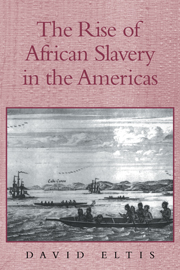Book contents
- Frontmatter
- Contents
- List of Tables
- List of Maps
- Preface
- Abbreviations
- Chapter 1 Slavery and Freedom in the Early Modern World
- Chapter 2 The English, the Dutch, and Transoceanic Migration
- Chapter 3 Europeans and African Slavery in the Americas
- Chapter 4 Gender and Slavery in the Early Modern Atlantic World
- Chapter 5 Productivity in the Slave Trade
- Chapter 6 Africa and Europe in the Early Modern Era
- Chapter 7 The African Impact on the Transatlantic Slave Trade
- Chapter 8 The English Plantation Americas in Comparative Perspective
- Chapter 9 Ethnicity in the Early Modern Atlantic World
- Chapter 10 Europe and the Atlantic Slave Systems
- Epilogue on Abolition
- Appendices
- Maps
- Sources and Bibliography
- Index
Chapter 3 - Europeans and African Slavery in the Americas
Published online by Cambridge University Press: 05 August 2012
- Frontmatter
- Contents
- List of Tables
- List of Maps
- Preface
- Abbreviations
- Chapter 1 Slavery and Freedom in the Early Modern World
- Chapter 2 The English, the Dutch, and Transoceanic Migration
- Chapter 3 Europeans and African Slavery in the Americas
- Chapter 4 Gender and Slavery in the Early Modern Atlantic World
- Chapter 5 Productivity in the Slave Trade
- Chapter 6 Africa and Europe in the Early Modern Era
- Chapter 7 The African Impact on the Transatlantic Slave Trade
- Chapter 8 The English Plantation Americas in Comparative Perspective
- Chapter 9 Ethnicity in the Early Modern Atlantic World
- Chapter 10 Europe and the Atlantic Slave Systems
- Epilogue on Abolition
- Appendices
- Maps
- Sources and Bibliography
- Index
Summary
Sub-Saharan regions were not the only parts of Africa for which European ships laden with goods set out to obtain people. In the seventeenth and eighteenth centuries, the Dutch and English, in particular, periodically sought slaves from the Mediterranean ports of North Africa. Here, however, the slaves were invariably white, and their fate, after their African owners had received the appropriate amount of goods, was not hard labor in the Americas but rather reentry into the nascent West European free labor market. In striking contrast to their attitudes toward non-Europeans a little to the south, European governments extended “Compassion to the Poor Slaves” and negotiated the redemption of their compatriots after the Barbary Powers had enslaved the latter. Down to the 1640s there were more English slaves in North Africa than there were African slaves under English control in the Caribbean. Release of the former became feasible when the “Emperor of Fez and Morocco … [sent] word what English Comodities he will have in Exchange for them ….” Clearly by the seventeenth century there was a slave-free dichotomy within Europe that followed the divide between Africans and Europeans. Why did a century or more have to pass before significant numbers of Europeans found similar compassion for Africans carried across the Atlantic? Indeed, why, from a broader perspective, should Europeans feel it necessary to seek the release of their fellows held in captivity?
- Type
- Chapter
- Information
- The Rise of African Slavery in the Americas , pp. 57 - 84Publisher: Cambridge University PressPrint publication year: 1999



